Ancient time for Rome is characterized by an extraordinary interest in everything large-scale and aesthetic. The era is marked by the construction of grandiose buildings and structures, including traditional Roman thermal baths. The name of each newly built baths was given in honor of the ruling emperor.
The establishment of the imperial thermal baths implies the existence of changing rooms (apoditeria), two swimming pools (piscina with water at room temperature and frigidarium — with cold water) hot water steam with hot pool (caldarium) and a steam bath (laconicum). Almost all baths were supplemented with oleatoriums, where vessels with aromatic oils were kept. Heating of thermal baths was due to horizontal underground channels with hot water. Before going to the baths, people were engaged in gymnastics to prepare the body for the loads. After in the water and steam baths, the skin was scraped with special blades, which were made of precious metals or materials of animal origin. They were chosen based on the state of human skin, because each had its beneficial effects. Romans tenderly treated the body care: carefully cleaned contamination, removed calluses from feet, used moisturizing and nourishing agents (oils, ointments, etc.), heavily used aromatic essences, women got rid of cellulite.
Visiting the steam rooms was accompanied by swimming in the pools: first in warm water, then in cold. At the end of the procedures, the body was embalmed Often, the processes of cleaning and ennobling of the body were carried out by slaves of wealthy Romans, whom the latter took with them to the baths. Incredibly, the imperial baths were truly huge buildings, for example, the famous the Baths of Caracalla had an area of about 30 square kilometers! The bath complex was designed for a simultaneous visit of more than 2 thousand of people and contained a system of swimming pools and steam rooms, gyms, libraries, shops, canteens, parks, stadium. At the same time, there were separate luxurious "bath rooms" for wealthy people and common rooms for the poorer ones. The interior amazed with the beauty: mosaic floors, marble benches, silver pipes, fountains and even artificial waterfalls.
It is thought that thermal baths are noble imperial gift to both rich citizens and the poor. After all, anyone found an occupation at option there: communicated, educated in libraries, rested, cleansed, renewed in soul and body and gained new power.

